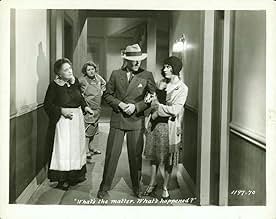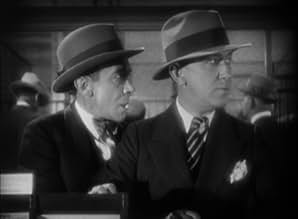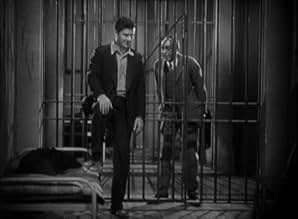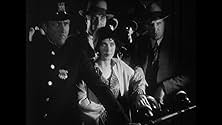VALUTAZIONE IMDb
6,5/10
987
LA TUA VALUTAZIONE
Thunderbolt, noto criminale, rischia l'esecuzione. Nella cella accanto c'è l'innocente Bob Moran, innamorato della ragazza di Thunderbolt. Questi spera di avere abbastanza tempo per poter uc... Leggi tuttoThunderbolt, noto criminale, rischia l'esecuzione. Nella cella accanto c'è l'innocente Bob Moran, innamorato della ragazza di Thunderbolt. Questi spera di avere abbastanza tempo per poter uccidere Moran.Thunderbolt, noto criminale, rischia l'esecuzione. Nella cella accanto c'è l'innocente Bob Moran, innamorato della ragazza di Thunderbolt. Questi spera di avere abbastanza tempo per poter uccidere Moran.
- Regia
- Sceneggiatura
- Star
- Candidato a 1 Oscar
- 2 vittorie e 1 candidatura in totale
Ernie Adams
- Thug in Bank at Robbery
- (non citato nei titoli originali)
Elmer Ballard
- Prisoner #8
- (non citato nei titoli originali)
Louise Beavers
- Black Cat Cafe Patron
- (non citato nei titoli originali)
Ed Brady
- Chuck - 1st Prisoner #5
- (non citato nei titoli originali)
Recensioni in evidenza
This film begins with the news that an elusive gangster nicknamed "Thunderbolt" (George Bancroft) is wanted for bank robbery and is considered armed and dangerous. That being said, as the film continues it is also revealed that Thunderbolt has a girlfriend named "Ritzi" (Fay Wray) that he is obsessed with. The problem is that Thunderbolt has become, not only extremely possessive of Ritzi, but somewhat abusive as well. So, because of that, Ritzi has since fallen in love with a gentle man named "Bob Moran" (Richard Arlen) who simply adores her. Needless to say, Thunderbolt becomes quite livid when he learns that Ritzi wants to break up with him because she has found another man. So much so that not even the death penalty can prevent him from getting his revenge. Now, rather than reveal any more, I will just say that I was pleasantly surprised with the menacing performance George Bancroft put in for this particular role. Absolutely outstanding. That being said, however, it's also quite obvious that all of the actors labored to some degree from the transition from silent films. An unfortunate byproduct of its time. Be that as it may, I still found this film to be entertaining for the most part and I have rated it accordingly. Slightly above average.
Nobody would argue that 1929 was a year of classic movies. Amongst the flotsam and jetsam however there's APPLAUSE and a few other good ones..... and this as well - almost. What a difference a top director and screenwriter can make!
This isn't a gangster film, it's an intelligently written character study and in-depth look into the mind of a mobster. You find writer Jules Furthman's name on virtually every other classic Hollywood picture of the 20s, 30s and 40s. His style was quality and his skill was creating believable engaging stories with real genuine characters. His story was further adapted by H Mankiewicz - who wrote the scripts for the probably the other half of the classics from this period. Needless to say - this is well written with fascinating and deeply faceted characters.
Josef von Sternberg directed this which by the look of it was his fiftieth talkie. Surely it's impossible that this was his first sound film? Being made in 1929, it's still a little experimental, not quite everything works so this is not one of his best pictures. Nevertheless he creates a brooding almost surreal atmosphere with real tension. That style intensifies significantly in the latter part of the film on death row which has an almost dream like feel about it.
The story is tense, the characters are believable, the production is innovative but this is not a perfect film. To enable clear sound recording, some but not all of the actors speak very slowly which sounds especially weird when the actor they're talking with is speaking normally. Actors had their own individual vocal coaches then with different techniques thus the inconsistency and maybe not being a native English speaker, von Sternberg probably didn't notice the subtle differences.
As great a director as he was, von Sternberg was given the impossible task of trying to make Fay Wray seem like a proper actress. Not even he could do that and predictably she's absolutely dreadful. As always she just projects that limp, whining and insipid expression to convey whatever emotion she's trying to express.
Whether she's pretending to be a hard as nails gangster's moll or a reformed, sweet and vulnerable fragile young thing she's that same bland, shallow character. Not only can't she act but in this she doesn't appear to be able to speak English - what on earth is that accent! She's meant to be a girl from the streets so why is she doing history's worst impression of Queen Mary? That two men could be besotted with this dull sour-faced non-entity completely stretches all credibility.
This isn't a gangster film, it's an intelligently written character study and in-depth look into the mind of a mobster. You find writer Jules Furthman's name on virtually every other classic Hollywood picture of the 20s, 30s and 40s. His style was quality and his skill was creating believable engaging stories with real genuine characters. His story was further adapted by H Mankiewicz - who wrote the scripts for the probably the other half of the classics from this period. Needless to say - this is well written with fascinating and deeply faceted characters.
Josef von Sternberg directed this which by the look of it was his fiftieth talkie. Surely it's impossible that this was his first sound film? Being made in 1929, it's still a little experimental, not quite everything works so this is not one of his best pictures. Nevertheless he creates a brooding almost surreal atmosphere with real tension. That style intensifies significantly in the latter part of the film on death row which has an almost dream like feel about it.
The story is tense, the characters are believable, the production is innovative but this is not a perfect film. To enable clear sound recording, some but not all of the actors speak very slowly which sounds especially weird when the actor they're talking with is speaking normally. Actors had their own individual vocal coaches then with different techniques thus the inconsistency and maybe not being a native English speaker, von Sternberg probably didn't notice the subtle differences.
As great a director as he was, von Sternberg was given the impossible task of trying to make Fay Wray seem like a proper actress. Not even he could do that and predictably she's absolutely dreadful. As always she just projects that limp, whining and insipid expression to convey whatever emotion she's trying to express.
Whether she's pretending to be a hard as nails gangster's moll or a reformed, sweet and vulnerable fragile young thing she's that same bland, shallow character. Not only can't she act but in this she doesn't appear to be able to speak English - what on earth is that accent! She's meant to be a girl from the streets so why is she doing history's worst impression of Queen Mary? That two men could be besotted with this dull sour-faced non-entity completely stretches all credibility.
For some reason I thought this film was a talkie remake by Josef von Sternberg of his great silent Underworld. Although George Bancroft is again the star here (and won an Oscar nomination for best actor) this is an entirely different storyline.
Bancroft stars a a tough hood in love with Fay Wray. But she's trying to go straight with Richard Arlen, who works in a bank. A man hunt captures Bancroft and convicts him to death row. But even from the cell, Bancroft is able to frame Arlen for a murder during a ban robbery. Arlen is sentenced to death row and ends up across the hall from Bancroft. Will there be fairness? Will there be redemption? As in Underworld, Bancroft is terrific as the obsessed and all-powerful thug. His voice is great as he growls and groans and threatens. Wray looks stunning, and Arlen is good as the innocent man.
For a 1929 talkie, this film has its stagnant moments when the editors didn't know when to cut. But it also features some terrific work by von Sternberg.
The entrance scene into the jazz club is a barrage of trellises and picket fences... quite beautiful... and also boasts a really nice song from Theresa Harris (who usually played a maid). There's also a wondrous scene where Arlen has been hurt and is being tended by his mother (Eugenie Besserer). While's she's applying iodine, he pulls his hands away and the bottle smashes. Both try to clean it up and the scene ends in a giggling tickle fight. Totally unexpected and totally wonderful.
Fred Kohler plays a convict. Tully Marshall is marvelous is a jittery warden.
The ending is probably expected but is beautifully done.
Bancroft stars a a tough hood in love with Fay Wray. But she's trying to go straight with Richard Arlen, who works in a bank. A man hunt captures Bancroft and convicts him to death row. But even from the cell, Bancroft is able to frame Arlen for a murder during a ban robbery. Arlen is sentenced to death row and ends up across the hall from Bancroft. Will there be fairness? Will there be redemption? As in Underworld, Bancroft is terrific as the obsessed and all-powerful thug. His voice is great as he growls and groans and threatens. Wray looks stunning, and Arlen is good as the innocent man.
For a 1929 talkie, this film has its stagnant moments when the editors didn't know when to cut. But it also features some terrific work by von Sternberg.
The entrance scene into the jazz club is a barrage of trellises and picket fences... quite beautiful... and also boasts a really nice song from Theresa Harris (who usually played a maid). There's also a wondrous scene where Arlen has been hurt and is being tended by his mother (Eugenie Besserer). While's she's applying iodine, he pulls his hands away and the bottle smashes. Both try to clean it up and the scene ends in a giggling tickle fight. Totally unexpected and totally wonderful.
Fred Kohler plays a convict. Tully Marshall is marvelous is a jittery warden.
The ending is probably expected but is beautifully done.
The High-Light of this "First-Year" of the All-Talkie Hollywood in Renowned Director Sternberg Film is the Harlem Night-Club.
This Takes Place in the First Half and while the Remainder of this Gangster-Romance is Peppered with a Few Interesting Flourishes,
None Equate the Impressive Opening and Once the Movie Gets to Prison the Film is Absent Sternberg's Signature Touches.
In Face the Movie Grinds to a Halt and is just Uninteresting Banter and Prison's Inanimate Existence.
The Dialog Deliveries are Pause Laden, Rhythmic Readings that are Stiff, Laborious, and so Wearily Dated as to be Painful.
Fay Wray is Hardly a Presence, Richard Arlen is OK, and George Bancroft (Oscar Nominated) is Domineering but Hardly Special.
Overall, a Curiosity and Film Historians Should Give it a Look for Context and the Director's Complete Filmography.
But Casual Movie Fans and Seekers of some "Old-Stuff" are Likely to be Bored to Death and Very Disappointed.
This Takes Place in the First Half and while the Remainder of this Gangster-Romance is Peppered with a Few Interesting Flourishes,
None Equate the Impressive Opening and Once the Movie Gets to Prison the Film is Absent Sternberg's Signature Touches.
In Face the Movie Grinds to a Halt and is just Uninteresting Banter and Prison's Inanimate Existence.
The Dialog Deliveries are Pause Laden, Rhythmic Readings that are Stiff, Laborious, and so Wearily Dated as to be Painful.
Fay Wray is Hardly a Presence, Richard Arlen is OK, and George Bancroft (Oscar Nominated) is Domineering but Hardly Special.
Overall, a Curiosity and Film Historians Should Give it a Look for Context and the Director's Complete Filmography.
But Casual Movie Fans and Seekers of some "Old-Stuff" are Likely to be Bored to Death and Very Disappointed.
Sternberg's first Talkie is virtually a retread of his UNDERWORLD (1927), with the same leading man – George Bancroft – no less. However, while ably flanked by his co-stars there, he is practically the whole show this time around (Fay Wray and Richard Arlen being no match for Evelyn Brent and Clive Brook) and, consequently, the role earned Bancroft his sole Oscar nomination (and the film's as well)! Anyway, the director's approach to Sound was not as experimental as may have been anticipated (resorting to Death Row histrionics and even a number of songs to showcase the format!) and the end result is hardly dazzling in this regard – though the dialogue is surprisingly clean, i.e. audible, for such an early example. Conversely, the visual aspect of the film, usually the director's main concern, is greatly diluted here through the poor quality of the copy I watched which also sported forced German subtitles!
Bancroft is once again a gangster (as before, his activity remains undisclosed throughout, apart from lording it up in an almost exclusively-black nightclub!) and his moll eventually leaves him for another, younger and handsomer, man. Here, too, the mobster is caught and imprisoned – in a wonderful scene where he shows compassion for a mutt, subsequently proving inseparable, thus preceding Raoul Walsh's HIGH SIERRA by 12 years! Yet, he ingeniously has his associates frame the rival for a murder they committed (the development of this particular plot strand is unfortunately rather muddled) and the hero winds up in the cell opposite Bancroft's. As in UNDERWORLD, Fred Kohler also appears here to antagonize the latter – besides lanky warden Tully Marshall and an Irish guard whose name the protagonist continually tries to guess (with the droll pay-off coming at the film's very conclusion).
Wray and her mother plead with the gangster to do the right thing and clear Arlen of his crime but, of course, he will have none of that at the start. Again, however, Bancroft is softened and confesses his role in the young man's entrapment just hours before his execution is due; I have to wonder here why he, a first-time felon, is scheduled to die before the much sought-after "Thunderbolt"! – yes, the film's title is a reference to the character's nick-name. In any case, the moll's own admission that she had left her lover for the gangster rather than the other way around makes the latter realize, as was the case in UNDERWORLD, that he is in the way and gladly accepts his fate. Incidentally, speaking of references to the director's earlier work, Wray and Arlen are made to undergo a hasty marriage here – much like Bancroft himself and Betty Compson in THE DOCKS OF NEW YORK (1928)!
Bancroft is once again a gangster (as before, his activity remains undisclosed throughout, apart from lording it up in an almost exclusively-black nightclub!) and his moll eventually leaves him for another, younger and handsomer, man. Here, too, the mobster is caught and imprisoned – in a wonderful scene where he shows compassion for a mutt, subsequently proving inseparable, thus preceding Raoul Walsh's HIGH SIERRA by 12 years! Yet, he ingeniously has his associates frame the rival for a murder they committed (the development of this particular plot strand is unfortunately rather muddled) and the hero winds up in the cell opposite Bancroft's. As in UNDERWORLD, Fred Kohler also appears here to antagonize the latter – besides lanky warden Tully Marshall and an Irish guard whose name the protagonist continually tries to guess (with the droll pay-off coming at the film's very conclusion).
Wray and her mother plead with the gangster to do the right thing and clear Arlen of his crime but, of course, he will have none of that at the start. Again, however, Bancroft is softened and confesses his role in the young man's entrapment just hours before his execution is due; I have to wonder here why he, a first-time felon, is scheduled to die before the much sought-after "Thunderbolt"! – yes, the film's title is a reference to the character's nick-name. In any case, the moll's own admission that she had left her lover for the gangster rather than the other way around makes the latter realize, as was the case in UNDERWORLD, that he is in the way and gladly accepts his fate. Incidentally, speaking of references to the director's earlier work, Wray and Arlen are made to undergo a hasty marriage here – much like Bancroft himself and Betty Compson in THE DOCKS OF NEW YORK (1928)!
Lo sapevi?
- QuizOne of the earliest of over 700 Paramount productions, filmed between 1929 and 1949, which were sold to MCA/Universal in 1958 for television distribution, and have been owned and controlled by MCA ever since. However, because of its extreme age, and primitive sound recording techniques, there is no record of it ever having been locally televised. On cable TV it received what may have been its first and only telecast on Turner Classic Movies in August 2016.
- Versioni alternativeMade in both sound and silent versions.
I più visti
Accedi per valutare e creare un elenco di titoli salvati per ottenere consigli personalizzati
- How long is Thunderbolt?Powered by Alexa
Dettagli
- Data di uscita
- Paese di origine
- Lingua
- Celebre anche come
- Thunderbolt
- Luoghi delle riprese
- Azienda produttrice
- Vedi altri crediti dell’azienda su IMDbPro
- Tempo di esecuzione1 ora 25 minuti
- Colore
Contribuisci a questa pagina
Suggerisci una modifica o aggiungi i contenuti mancanti



































